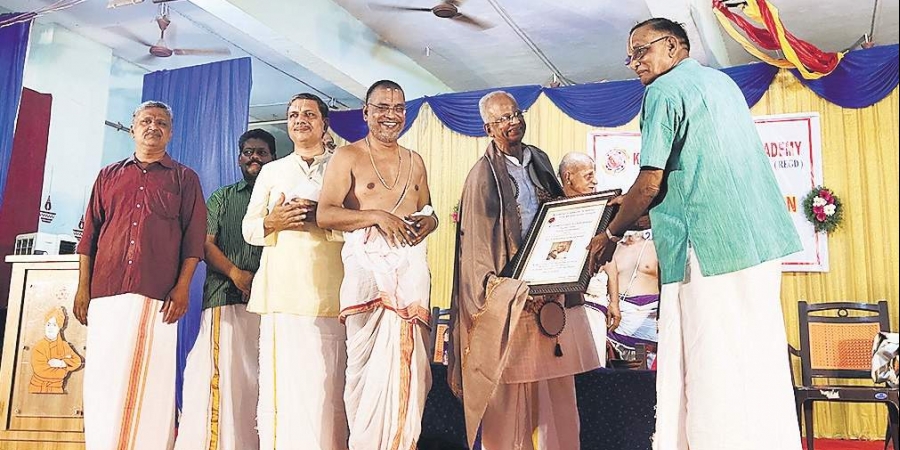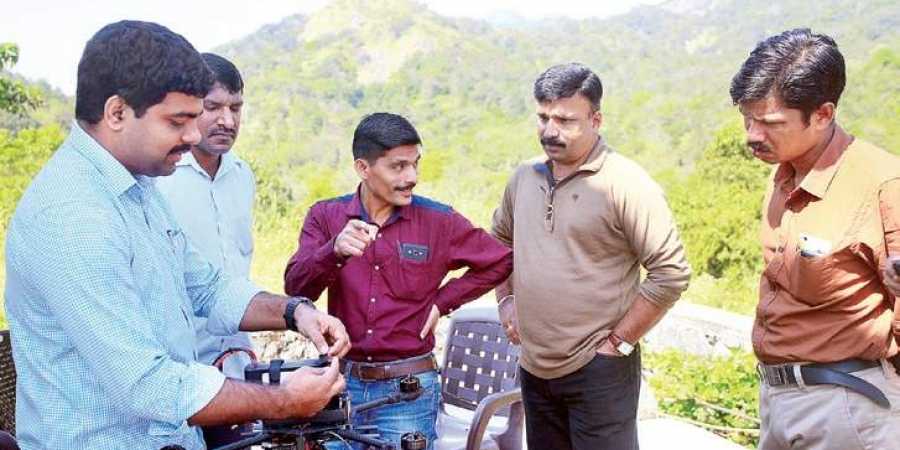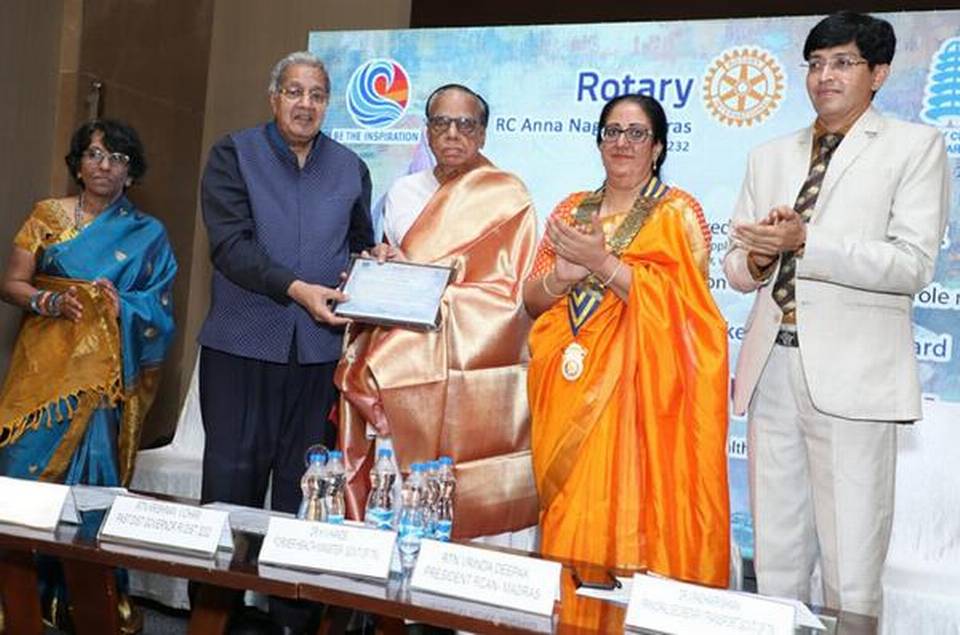23
22
21
20
19
18
TV Sankara Narayanan receives Nadhasudhamani Award

Padma Bhushan awardee and Sangita Kalanidhi TV Sankara Narayanan was conferred with the Nadhasudhamani award by Azhagiya Manavala Sampath Kumara Ramanuja Jeeyar Swamigal as a part of Korattur Cultural Academy’s eighth-anniversary celebrations on Tuesday at Dr Nalli Kuppuswamy Vivekananda Vidyalaya Junior College.
SV Raman, president, Korattur Cultural Academy welcomed the gathering. In his address, he said, “During the initial stages, we used to call up artistes and request them to perform at our academy. However, the standard has improved to a level where applications from the artistes are pouring in now.”
The title was conferred upon Sankara Narayanan as an appreciation for being a performer, creator, and mentor in the music community. This was followed by a speech from Jeeyar Swamigal.
T Chakravarthy, vice president, Vivekananda Educational Society presided as the guest of honour. Chakravarthy’s inaugural address was followed by Sankara Narayanan’s acceptance speech. “I am honoured to receive the award from Jeeyar Swamigal. Music has kept me close to god and I am glad to be able to sing about Govinda. Today being my mother’s birth anniversary, I dedicate this award to my parents,” said Naraynan. “Korattur Cultural Academy has made it possible to provide a platform for performing arts and cultural activities in an industrial area for the past eight years,” he added.
The award ceremony was followed by a dance drama — Choodi Kodutha Nachiyar by students of Bharatha Natyalaya, Anna Nagar.
Embar T Kannan, secretary, Korattur Cultural Academy was also present during the event.
source: http://www.newindianexpress.com / The New Indian Express / Home> Cities> Chennai / by Deepthi Parthasarathy / May 16th, 2019
Chennai engineers flying high on drone tech startup
This team of four engineers are going great guns since the launch of their start-up AI Aeronautics six months back.

Chennai :
This team of four engineers are going great guns since the launch of their start-up AI Aeronautics six months back. It has been incubated at Maker Village, and is making waves even in international market due to their penchant for customisation.
“The idea emerged while I was pursuing my PhD in Aerial Robotics and Artificial Intelligence. But, the idea to launch a start-up is a recent one,” said Vishnu V Nath, founder and VP, engineering. It was set up with a seed investment of Rs 15 lakh. “The money was pooled in by us. Later, we got Rs 10 lakh from the government as a part of Niti Prayas,” he said.
The aim was to develop a viable product that matches the requirement of the customer at a minimal cost. “We build a customised flying platform that can be used in reconnaissance, aerial 3D mapping for survey, smart agriculture and disaster management,” he said. The efficiency of the product was proved during a demonstration that was held for the State Disaster Management Authority.
“Our drone carried out an aerial 3D mapping of the flood-affected areas. It helped predict the level to which water will rise if the dams are opened again. This will help in disaster management,” he said.
The police and forest departments have also approached him. “We gave a demo to Kerala police. They want to use the product for surveillance, crowd monitoring and VIP security. Features like the ability to downlink high-resolution real-time videos, an artificial intelligence-based algorithm to detect and track the number plates of suspect vehicles and also identify persons of interest through facial recognition make our product attractive to them,” said Vishnu.
The hybrid UAV that AI Aeronautics has developed can fly up to two hours within a 40 km radius. “We worked with the Archaeology Department for a pilot project in which the UAVs were used for aerial mapping and disaster estimation by creating a map of the Aranmula Parthasarathy Temple,” he said.
At present, the start-up is doing a research project with IIT-MK. “We have successfully tested a prototype for DRDO in association with NPOL. The DRDO project is worth Rs 20 lakh. Another work amounting to Rs 8 lakh was done for a virtual reality company,” he said. The projects in the pipeline are a prototype that can carry a payload of one kilo. “Two other projects for prototypes that can carry five kg and 24 kg payloads too are underway,” he said.
The team is expecting a future investment of Rs 10 to Rs 15 lakh. “We want to use the domain efficiently. Also, we have been asked by Walmart to use the drones to help solve their space management issues,” he said.
In a Nutshell
● AI Aeronautics was started by four engineers six months ago.
● It was set up with a seed investment of Rs 15 lakh most of which was pooled in by them while the rest was funded by the Government under Niti Prayas
● The hybrid UAV that AI Aeronautics has developed can fly up to two hours within a 40 km radius.
● The team is expecting a future investment of Rs 10 to Rs 15 lakhs
source: http://www.newindianexpress.com / The New Indian Express / Home> Cities> Chennai / by Anu Kuruvilla / Express News Service / May 16th, 2019
Rotary confers ‘For the Sake of Honour Award’ on H.V. Hande

Former Health Minister stresses on importance of voting
The Rotary Club of Anna Nagar Madras conferred the “For the Sake of Honour Award” to former Health Minister of Tamil Nadu, H.V. Hande, on Monday.
The award is given to individuals who have rendered exemplary service to society. Addressing the gathering, Dr. Hande highlighted the role played by the Rotary in the Pulse Polio campaign.
Appeal to members
He appealed to Rotary members to educate the masses on the importance of casting a vote and stressed on the need to abstain from taking money to swear allegiance to a party.
He also recalled his confrontation with the British police while he was involved in India’s freedom movement as a student.
J. Radhakrishnan, Transport Secretary, felicitated Dr. Hande and said he was a guiding light and mentor to him. He also lauded his efforts in creating awareness about leprosy and treating patients, even at a time when there was no social media and technology.
Former district governor of Rotary Krishnan V. Chari and president of the club Vrinda Deepak were among those who took part in the event.
source: http://www.thehindu.com / The Hindu / Home> News> Cities> Chennai / by Special Correspondent / Chennai – May 15th, 2019